



3H2 Understand the block diagrams of the crystal diode receiver, and direct conversion receiver.
Place mouse pointer on diagram to see wave forms
The full circuit diagram of a crystal set which is an "AM radio signal receiver"
![]() Students do not
ignore this simple circuit. It is the most basic of all radios. NOTE: There
is no battery in the circuit as a crystal set does not need any external
power supply.
Students do not
ignore this simple circuit. It is the most basic of all radios. NOTE: There
is no battery in the circuit as a crystal set does not need any external
power supply.
Thus the crystal set is a "radio signal receiver" (or just "receiver") in its simplest form and was used almost when AM radio broadcast transmissions started.
The diode shown above is a modern day substitution for a piece of crystalline material (galena) and a fine wire known as a 'cat's whisker'. The fine wire had to find what was called the "sweet spot" on the galena else no radio station could be heard (as it would have been the same as taking the diode out of the circuit).
Finding the right spot on the galena was so critical that even changes due to slight vibration lost the signal. Those were the days of so called "Real Radio". Today we have the easy way out as manufacturers have developed the diode and a crystal set can easily be made from "simple to obtain" components.
So how does it work?
The RF signal (RF energy) is picked up by the antenna, as it is in all receivers, and goes into the tuned circuit. The circuit diagram above shows a parallel tuned circuit, which can be tuned to the desired radio station (frequency) by the variable capacitor.
At the resonant frequency, the parallel tuned circuit has a high impedance (or opposition to AC / RF currents), the effect of this is to generate a maximum AC / RF potential difference across the tuned circuit.
The potential difference is rectified by the diode and DC is smoothed out by the capacitor C. The end result is that the recovered audio is only the overall shape of the signal which is applied to the ear piece / headphones which would have been the same shaped audio signal used to modulate the transmitter hence you hear what was transmitted. Simple Eh!!
The TRF
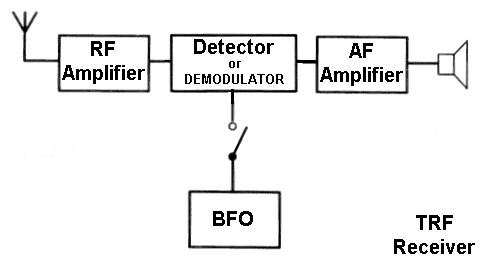
The Tuned Radio Frequency receiver is also known as a direct conversion receiver, is used for AM signals and with the BFO ( beat frequency oscillator ) switched in can also receive CW signals.
Understand the functions of the RF amplifier, demodulator (detector), and audio amplifier as used in an analogue receiver.
RF Amplifier
RF has a RF Amplifier (also called a Radio Frequency Stage or (RF) Stage). This stage amplifies the incoming signal from the antenna before it passes it to the detector or demodulator stage.
The detector ( also call the demodulator)
The detector recovers the AM signal and operates on the same principal as the crystal set but has the advantage that the an amplified signal is provided by the RF amplifier stage. Then the recovered audio is passed to the Audio Amplifier stage.
Audio Amplifier
The Audio Amplifier stage simply makes the recovered audio signal louder so that it is sufficient to hear in a loudspeaker.
BFO
The detector mixing with the BFO recovers the CW signal
As mentioned above the detector recovers the AM signal and with the BFO switched in a CW signal can be resolved as a beat tone. Then the recovered audio is passed to the Audio Amplifier Stage.
3H3 Recall that a receiver’s ability
to detect weak signals is known as its sensitivity.
Recall that very strong signals can overload a receiver and cause distortion to the audio output.
3H4 Recall that a receiver’s ability to reject frequencies outside the wanted signal bandwidth is known as its selectivity.
The rejection or selection of signals all depends upon the Q factor which stands for quality or goodness of the selector circuits. We saw this in our Technical basics section 2H4. Please go back and re-read this section.
Understand the limitations of tuned circuits in selecting wanted frequencies and the effect of the Q factor of tuned circuits.
The "sharpness" of the tuned signal at its half power points determines the bandwidth received. This can be as low as 100Hz for a c.w. signal or around 9KHz for an a.m. signal.
3I1 Understand the need for and advantages of the superheterodyne architecture.
The main reason for a superheterodyne architecture (superhet) is for producing better selectivity of signals in our crowded radio bands. It also provides better stability of the oscillators and more precise tuning.
The Superhet Receiver
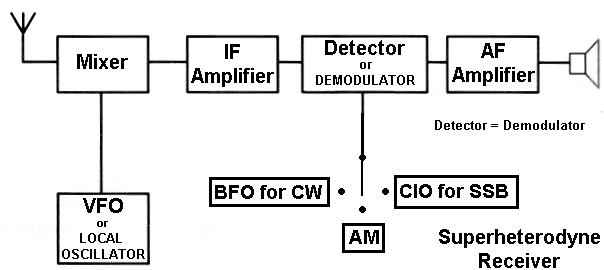
This is the superhet receiver a receiver which in its basic form receiver AM signals and by switching in a CIO (carrier insertion oscillator) can also be used to receive SSB signals or by switching in a BFO (Beat Frequency Oscillator) can also receiver CW signals. How it works is perhaps best understood by considering each stage it turn as is done in the next part of the syllabus.
RF Amplifier
(This is not in the drawing provided in the syllabus but as it is in the text of the syllabus as given above).
Amplifies the wanted weak signal from the antenna while largely ignoring signals outside of the required range by the use of tuned circuits
Mixer
Mixes the wanted amplified RF signal with the VFO signal (or as it is sometimes stated, with the local oscillator signal to produce sum and difference frequencies of the RF signal and the LO signal which in fact are modulated identically to the incoming signal.
Local Oscillator (LO)
The LO is the VFO which generates an RF signal for use by the mixer.
Intermediate Frequency Amplifier (IF)
Provides the main amplification and includes a filter, which removes adjacent signals and wrong mixing products
Detector (or Demodulator means the same, is interchangeable)
The demodulator recovers the modulating audio signal
when used with the BFO (beat frequency oscillator) can recover CW signals
When used with a CIO (Carrier insertion oscillator) can recover SSB signals
![]() Students are missing
the important aspect of the DETECTOR section regarding the switching in of
either a CIO or BFO which enables an AM radio to recover SSB or CW signals,
in addition to AM signals.
Students are missing
the important aspect of the DETECTOR section regarding the switching in of
either a CIO or BFO which enables an AM radio to recover SSB or CW signals,
in addition to AM signals.
Audio Amplifier (AF amp)
Amplifies the signal to drive a loudspeaker.
3I2 Recall that the intermediate frequency is the sum of or difference between the RF and local oscillator frequencies, and is produced by a mixer.
![]() Please take enough
care to make certain that they understand the principle
that is being explained so this new drawing has been included to we hope
to aid understanding.
Please take enough
care to make certain that they understand the principle
that is being explained so this new drawing has been included to we hope
to aid understanding.
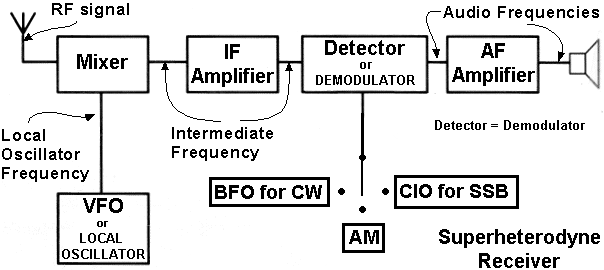
The Intermediate Frequency is created by either:-
Adding the frequency of the local oscillator to the RF or Subtracting the RF from the Local Oscillator frequency, (or if the local oscillator frequency is greater than the RF subtracting Local Oscillator frequency from the RF frequency).
The INTERMEDIATE FREQUENCY ( IF ) is the sum of or difference between the RF and LOCAL OSCILLATOR FREQUENCY.

Putting that another way the Intermediate frequency differs from the RF frequency by the value of the local oscillator by either addition or subtraction of the local oscillator frequency.
Have a look at the diagrams below.
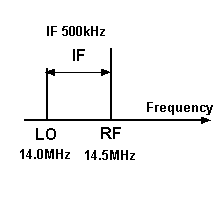
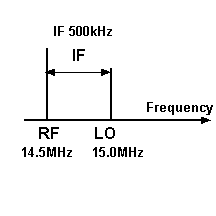
Note: there is no change in the IF only LO has changed
Here you may be asked to do some relatively simple calculation.
For instance with the RF and LO frequencies expressed in MHz to one decimal place the answer will be required in kHz.
A calculation like this may be asked :-
What is the IF if the RF is 7.1MHz the LO 6.6MHz
thus 7.1 - 6.6 = 0.5MHz = 500 kHz
![]()
There is also the possibility that the IF could be the sum of the RF and LO as in HF receivers where a first IF exists well above the tuning range.
3I3 Recall that a superheterodyne receiver uses a fixed IF stage to enable good selectivity and that mixing ahead of the IF enables multi.band reception.
Superheterodyne Receiver
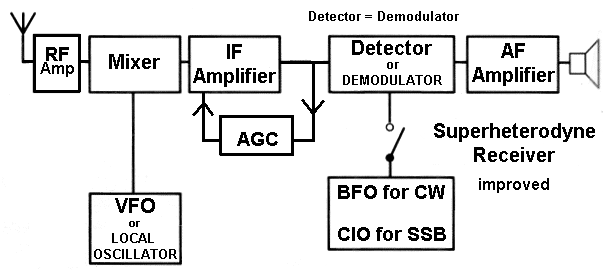
In the diagram above the RF Amplifier can also incorporate a Pre-selector.
A pre-selector within the RF Amplifier is a band-pass filter that blocks frequencies other than the wanted frequency from passing through from the antenna into the radio receiver's mixer stage. in other words it pre-selects the wanted frequency !!
The original signal mixes with the 1st Local Oscillator to give the Intermediate frequency and this frequency passes through all the other stages until the stages which extract the audio as AM, SSB, CW, FM and pass this recovered audio to the Noise limiter and onto the Audio Amplifier.
The AGC can also extend to the RF amplifier and can be the source of voltage for a "S" meter.
The use of good filters fitted to IF Amplifier will be the key to good selectivity.
Local Oscillator (LO)
The LO is the VFO which generates an RF signal for use by the mixer. The circuit of the Local Oscillator has to give a clean and stable signal to the mixer circuit BUT it must be tunable .The local oscillator must be based on a tuned circuit for example a frequency synthesiser type or it can use a direct digital synthesis also known as DDS.
RF Amplifier
Amplifies the wanted weak signal from the antenna while largely ignoring signals outside of the required range by the use of tuned circuits
Intermediate Frequency Amplifier(IF)
The initial RF amplifier will have removed the image channel but there may well still be other frequencies adjacent to the wanted frequency. The IF, which has a high Q factor and fixed frequency must select and then amplify this wanted signal and it provides the main amplification and includes filters, which removes adjacent signals and wrong mixing products.
AGC (Automatic Gain Control)
Detector(or Demodulator means the same - is interchangeable)
The demodulator recovers the modulating audio signal
Audio Amplifier (AF amp)
Amplifies the signal to drive a loudspeaker.
Understand that tuned circuits in RF and IF amplifiers select the wanted signal.
It is the tuned circuits in the RF and IF amplifiers that select the signal that you eventually hear in the loud speaker.
RF amplifiers are often what is called "fairly broad band" and thus quite a few stations signals will be mixed down to the IF. Then the much narrower IF tuned circuit selects the one wanted signal.
Identify the tuned circuits in the circuit of an IF amplifier.
3K1 Understand how a diode detector will recover the audio from amplitude modulated signals.
Understand that to generate the audio from CW signals a Beat Frequency Oscillator (BFO) is used; for the recovery of single sideband audio a carrier insertion oscillator (CIO) and product detector are used and for the recovery of FM audio a discriminator is used.
Identify the waveforms produced in a diode AM detector.
Place mouse pointer on graphic to see animation
The AM modulated RF comes in via the aerial is rectified by the diode and the capacitor smoothes it all out to become the recovered audio.
3L1 Understand that the automatic gain control (AGC) of a receiver operates by sensing the strength of the received signals at the detector and adjusting the gain of the IF and sometimes the RF amplifiers to keep the audio output level fairly constant.
If you have done any SWL (short wave listening) you may have noticed that the signal level that you hear remains fairly constant. This is almost certainly due to the AGC or Automatic Gain Control in the receiver circuit that has an effect on the speaker volume.
The strength of the signal at the detector is used to control the gain of the IF amplifier (and also some times the RF amplifier) so the weak signals are amplified more than stronger signals before they are passed to the loudspeaker..
The effect is that you hear sounds of approximately equal loudness. This avoids the signal going too quiet or too loud and distorted requiring you to turn the AF control up and down all the time. Clever eh !!
Recall that the AGC signal can also drive a signal strength meter (S-meter).
The AGC line has a voltage on it that is derived from the output of the IF amplifier stage. The voltage increases or decreases according to the strength of the received signal. We can use this varying voltage to drive a signal strength meter ( called an s-meter ) to indicate signal strength received.